Empirical Models for Surface Roughness and Topography in 5-Axis Milling Based on Analysis of Lead Angle and Curvature Radius of Sculptured Surfaces
Abstract
:1. Introduction
2. Five-Axis Milling Process of Sculptured Surfaces
2.1. Definition of Tool Axis Orientation and Experimental Model of Sculptured Surfaces with Variable Radii of Curvature
2.2. Materials and Tools
2.3. Experimental and Empirical Procedure and Research Technology
3. Results and Discussion
3.1. Surface Roughness
3.1.1. Ra Roughness Parameter
3.1.2. Rz Roughness Parameter
3.2. Surface Topography
4. Summary
- 1)
- Both the curvature radius ρ1 and the lead angle α affected the surface roughness and topography of the convex and concave surface of the turbine blade. An increase in the value of the lead angle α across the entire established range caused the reduction in the roughness Ra and Rz parameters in both cases of the analyzed surfaces.
- 2)
- It was shown that the nature of the changes in the Ra and Rz parameters of the convex and concave surface roughness was nonlinear with an upward trend with an increase in the radius of curvature ρ1. The largest growth in the value of these parameters occurred above the radius values ρ1 = 175 mm for a convex surface and ρ1 = 80 mm for a concave surface.
- 3)
- Within the range of the tested values of the angle α and the curvature radius ρ1, the geometrical structure (topography) of the convex and concave surface was characterized by periodicity in the feed direction of the tool, and in the transverse feed direction of the tool. It was found that the periodicity of these surfaces mainly depended on the kinematic and geometric mapping of the round cutting insert of the toroidal cutter on the machined surface.
- 4)
- It was found that the values of the Sa and Sz parameters of both analyzed surfaces increased with a growth in the radius of curvature ρ1. In these cases, no significant influence of the α angle on the above parameters was found.
- 5)
- It was also found that within the lower and middle level of the lead angle α values tested, the obtained surfaces had plate-shaped hills, while within the middle and upper level of the angle α parameter, these surfaces had sharpened hills.
- 6)
- It was observed that as the value of the lead angle α increased, the active cutting edge length of the toroidal cutter was lengthened and the roughness profile grooves were lengthened in the direction of feed.
Author Contributions
Funding
Conflicts of Interest
References
- Lavernhe, S.; Quinsat, Y.; Lartigue, C. Model for the prediction of 3D surface topography in 5-axis milling. Int J. Adv. Manuf. Technol. 2010, 51, 915–924. [Google Scholar] [CrossRef] [Green Version]
- Lim, T.-S.; Lee, C.-M.; Kim, S.-W.; Lee, D.-W. Evaluation of cutter orientations in 5-axis high speed milling of turbine blade. J. Mater. Process. Technol. 2002, 130–131, 401–406. [Google Scholar] [CrossRef]
- Wieczorek, B. Technologia Turbin Parowych, 1st ed.; Państwowe Wydawnictwa Techniczne: Warszawa, Rzeczpospolita Polska, 1961. [Google Scholar]
- Cao, Q.Y.; Zhao, J.; Zhu, L. The effect of curvature radius of sculptured surface on finish milling tool path selection. Int J. Adv. Manuf. Technol. 2017, 89, 3349–3357. [Google Scholar] [CrossRef]
- Yao, C.; Tan, L.; Yang, P.; Zhang, D. Effects of tool orientation and surface curvature on surface integrity in ball end milling of TC17. Int. J. Adv. Manuf. Technol. 2018, 94, 1699–1710. [Google Scholar] [CrossRef]
- Toh, C.K. Cutter path orientations when high-speed finish milling inclined hardened steel. Int J. Adv. Manuf. Technol. 2006, 27, 473–480. [Google Scholar] [CrossRef]
- Chen, X.; Zhao, J.; Dong, Y.; Han, S.; Li, A.; Wang, D. Effects of inclination angles on geometrical features of machined surface in five-axis milling. Int. J. Adv. Manuf. Technol. 2013, 65, 1721–1733. [Google Scholar] [CrossRef]
- Chen, X.; Zhao, J.; Dong, Y.; Li, A.; Wang, D. Research on the machined surface integrity under combination of various inclination angles in multi-axis ball end milling. Proc. Inst. Mech. Eng. Part. B J. Eng. Manuf. 2014, 228, 31–50. [Google Scholar] [CrossRef]
- Ko, T.J.; Kim, H.S.; Lee, S.S. Selection of the Machining Inclination Angle in High-Speed Ball End Milling. Int J. Adv. Manuf. Technol. 2001, 17, 163–170. [Google Scholar] [CrossRef]
- Kalvoda, T.; Hwang, Y.-R. Impact of various ball cutter tool positions on the surface integrity of low carbon steel. Mater. Des. 2009, 30, 3360–3366. [Google Scholar] [CrossRef]
- Hendriko, H. Mathematical Model for Calculating Scallop Height of Toroidal Cutter in Five-Axis Milling. J. Eng. Appl. Sci. 2017, 12, 5. [Google Scholar]
- Segonds, S.; Seitier, P.; Bordreuil, C.; Bugarin, F.; Rubio, W.; Redonnet, J.-M. An analytical model taking feed rate effect into consideration for scallop height calculation in milling with torus-end cutter. J. Intell. Manuf. 2019, 30, 1881–1893. [Google Scholar] [CrossRef]
- Erdim, H.; Lazoglu, I.; Ozturk, B. Feedrate scheduling strategies for free-form surfaces. Int. J. Mach. Tools Manuf. 2006, 46, 747–757. [Google Scholar] [CrossRef]
- Manav, C.; Bank, H.S.; Lazoglu, I. Intelligent toolpath selection via multi-criteria optimization in complex sculptured surface milling. J. Intell. Manuf. 2013, 24, 349–355. [Google Scholar] [CrossRef]
- Rao, A.; Sarma, R. On local gouging in five-axis sculptured surface machining using flat-end tools. Comput. Aided Des. 2000, 32, 409–420. [Google Scholar] [CrossRef]
- Chen, T.; Li, C.; Wang, H. Tool path generation for five-axis sculptured surface machining with a toroidal cutter. Int. J. Mach. Mach. Mater. 2010, 8, 372. [Google Scholar] [CrossRef]
- Xie, J.; Zou, M.; Cui, X. Effect of curvature distribution feature o complex freeform surface on cnc milling performance. J. Mech. Eng. 2009, 45, 158–162. [Google Scholar] [CrossRef] [PubMed]
- Duan, X.; Yu, S.; Peng, F.; Jiang, G. Study of the Effect of Tool Orientation on Surface Roughness in Five-Axis Milling of 300M Steel. IOP Conf. Ser. Mater. Sci. Eng. 2018, 382, 022087. [Google Scholar] [CrossRef]
- Yang, P.; Yao, C.; Xie, S.; Zhang, D.; Tang, D.X. Effect of Tool Orientation on Surface Integrity During Ball End Milling of Titanium Alloy TC17. Procedia CIRP 2016, 56, 143–148. [Google Scholar] [CrossRef] [Green Version]
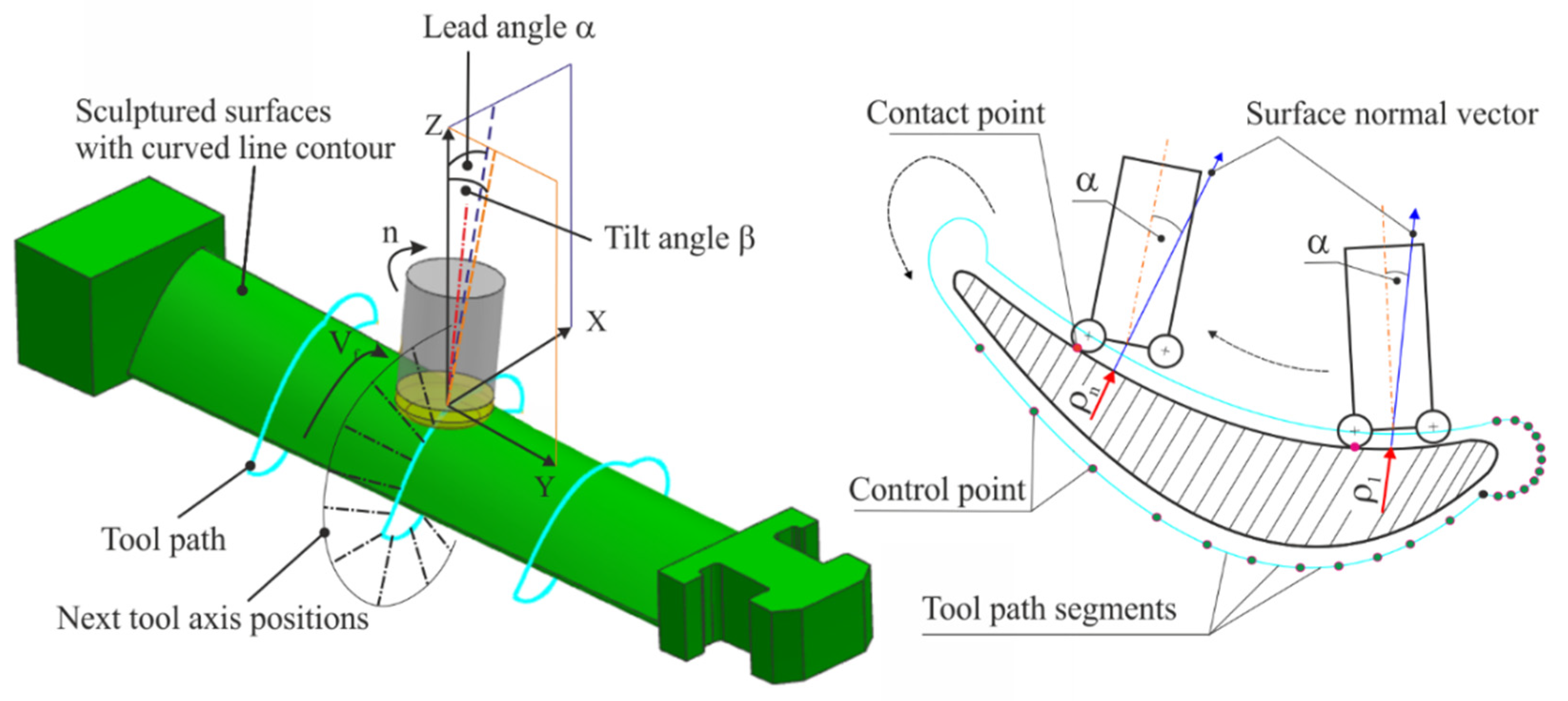


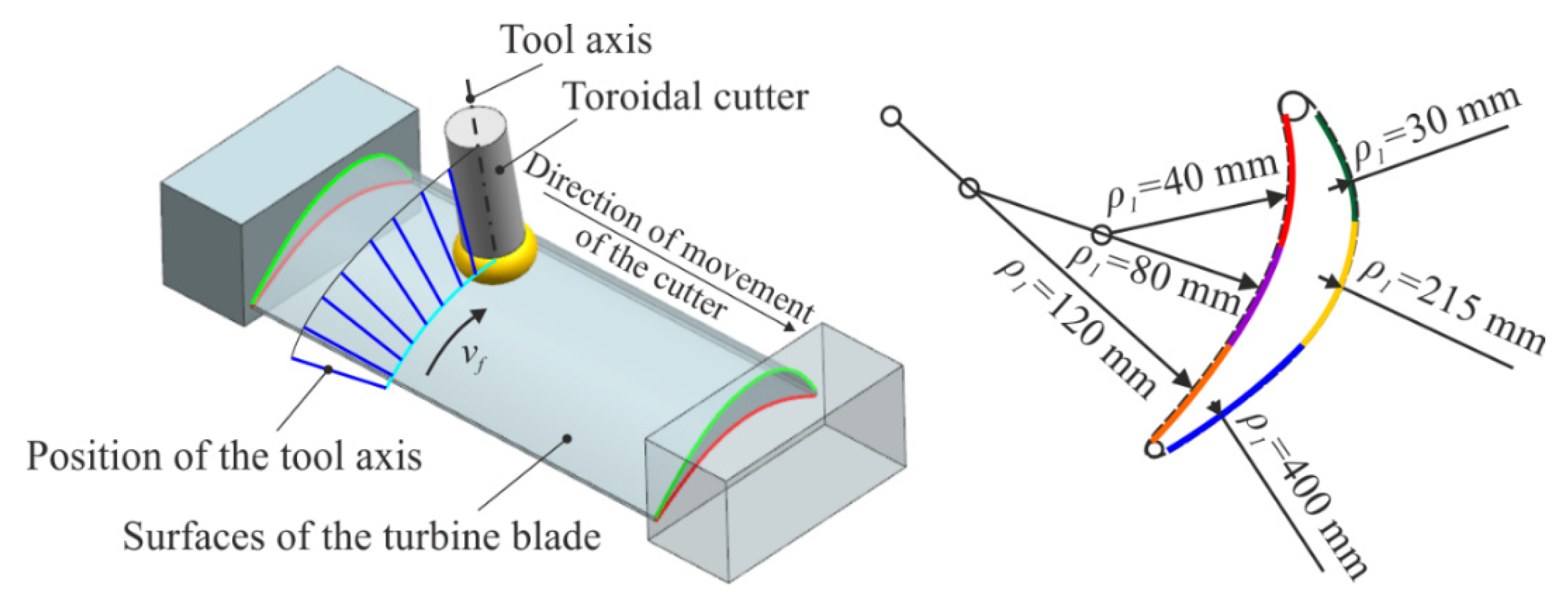

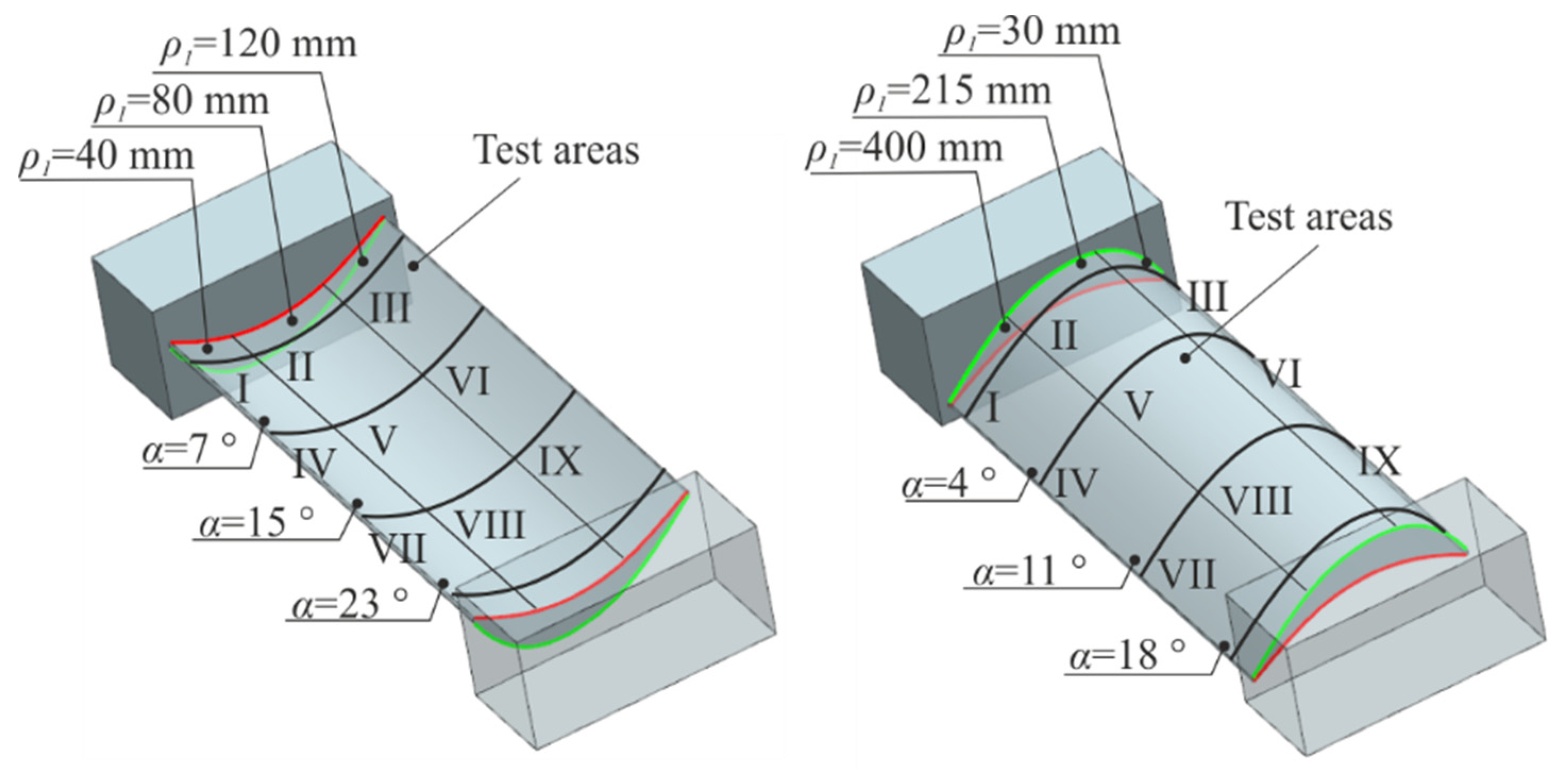

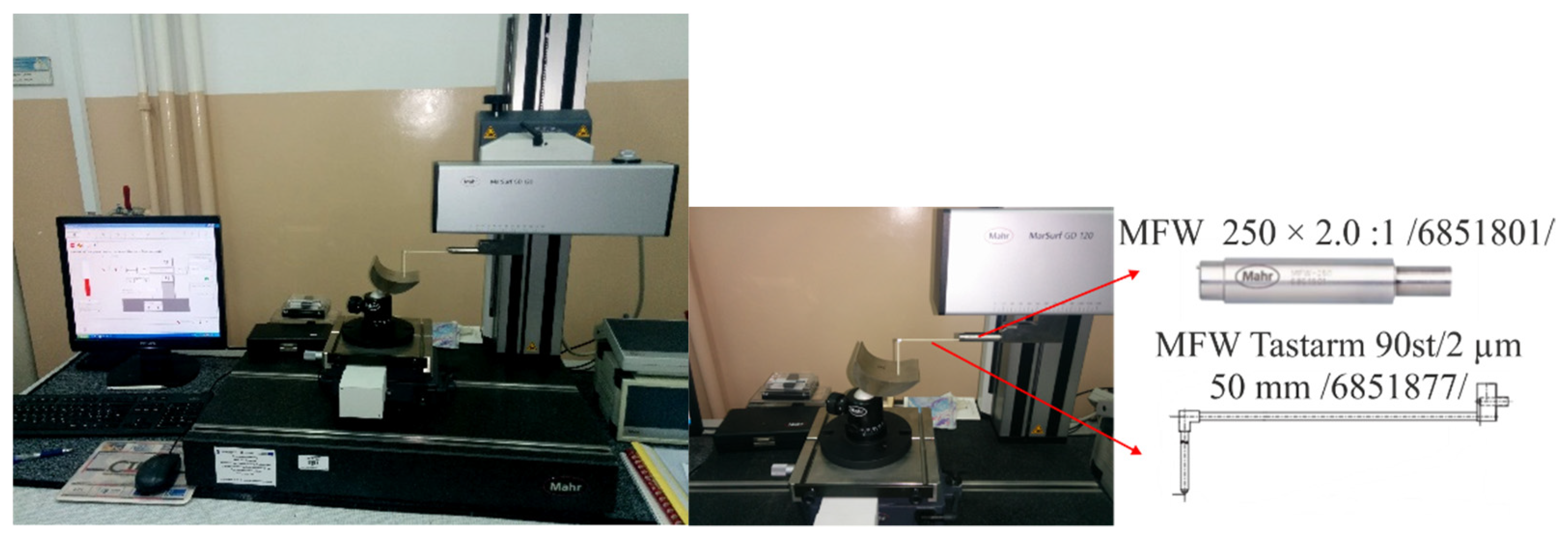
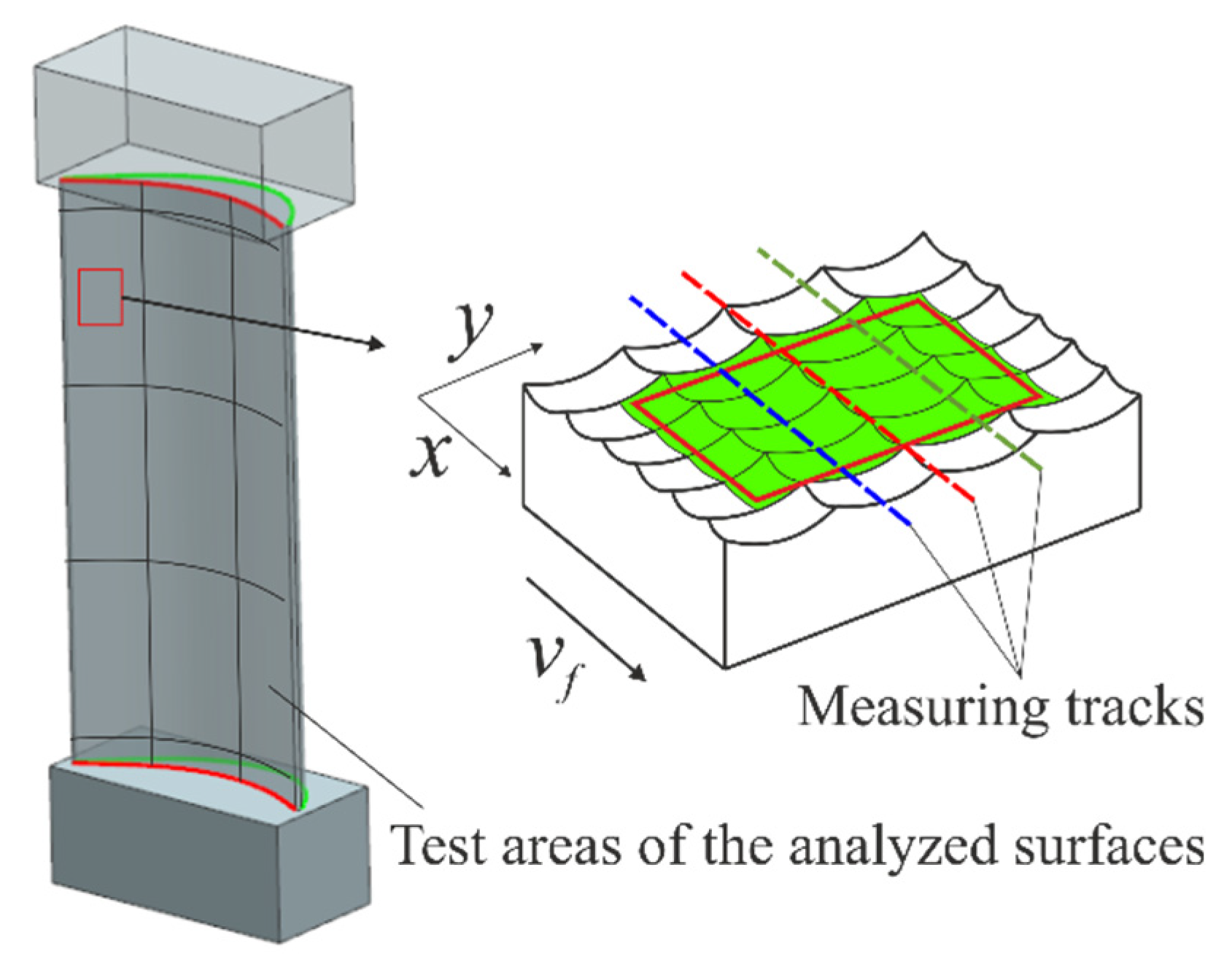
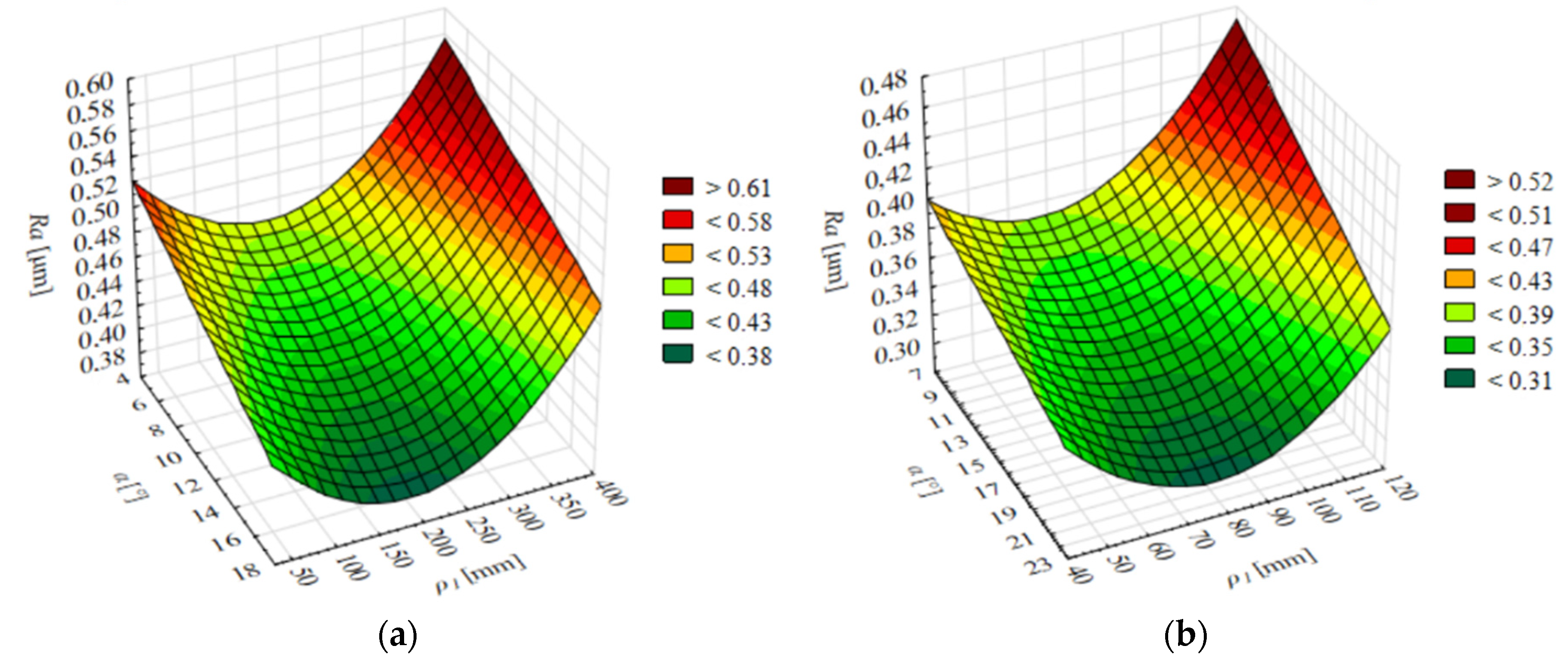
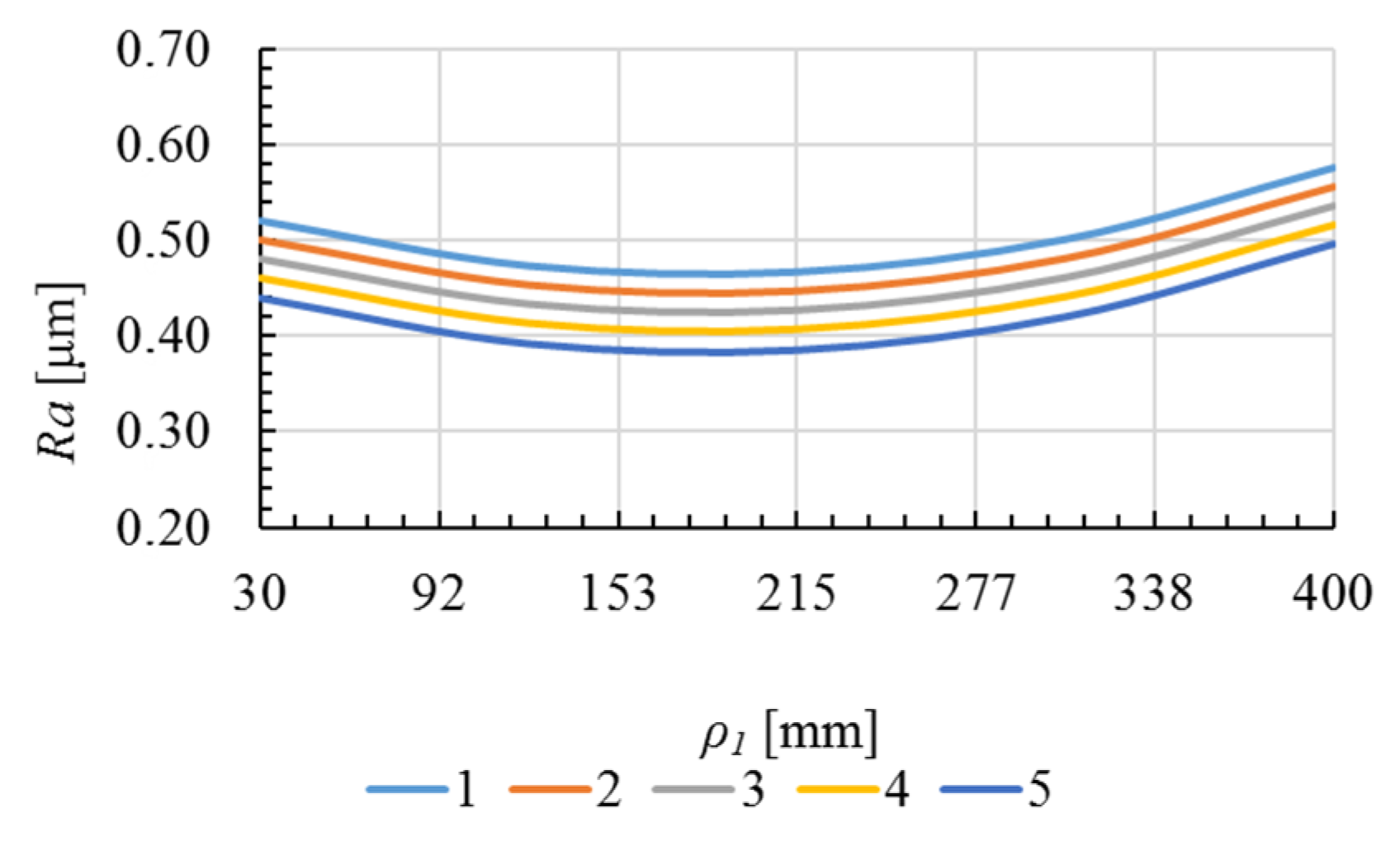

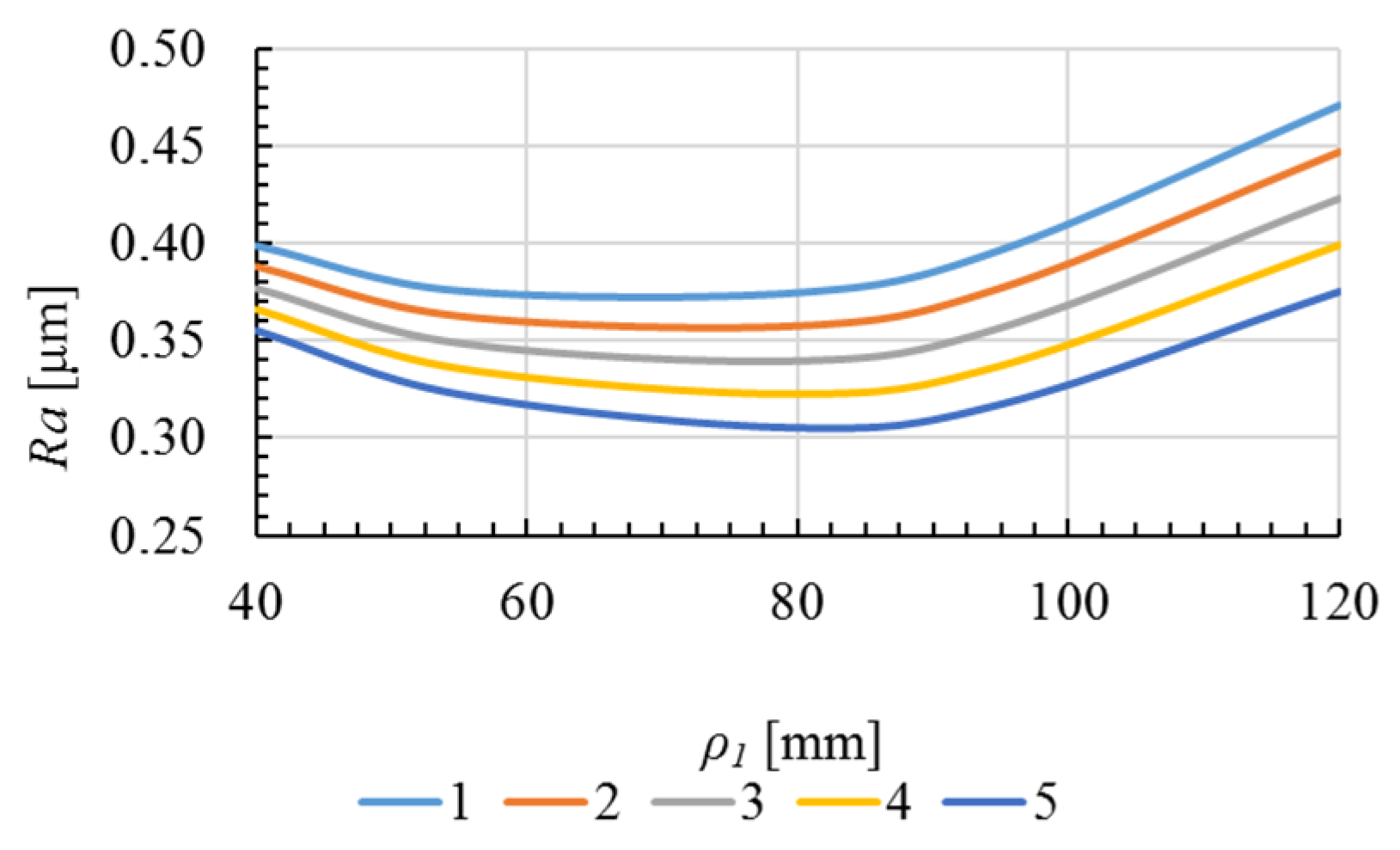
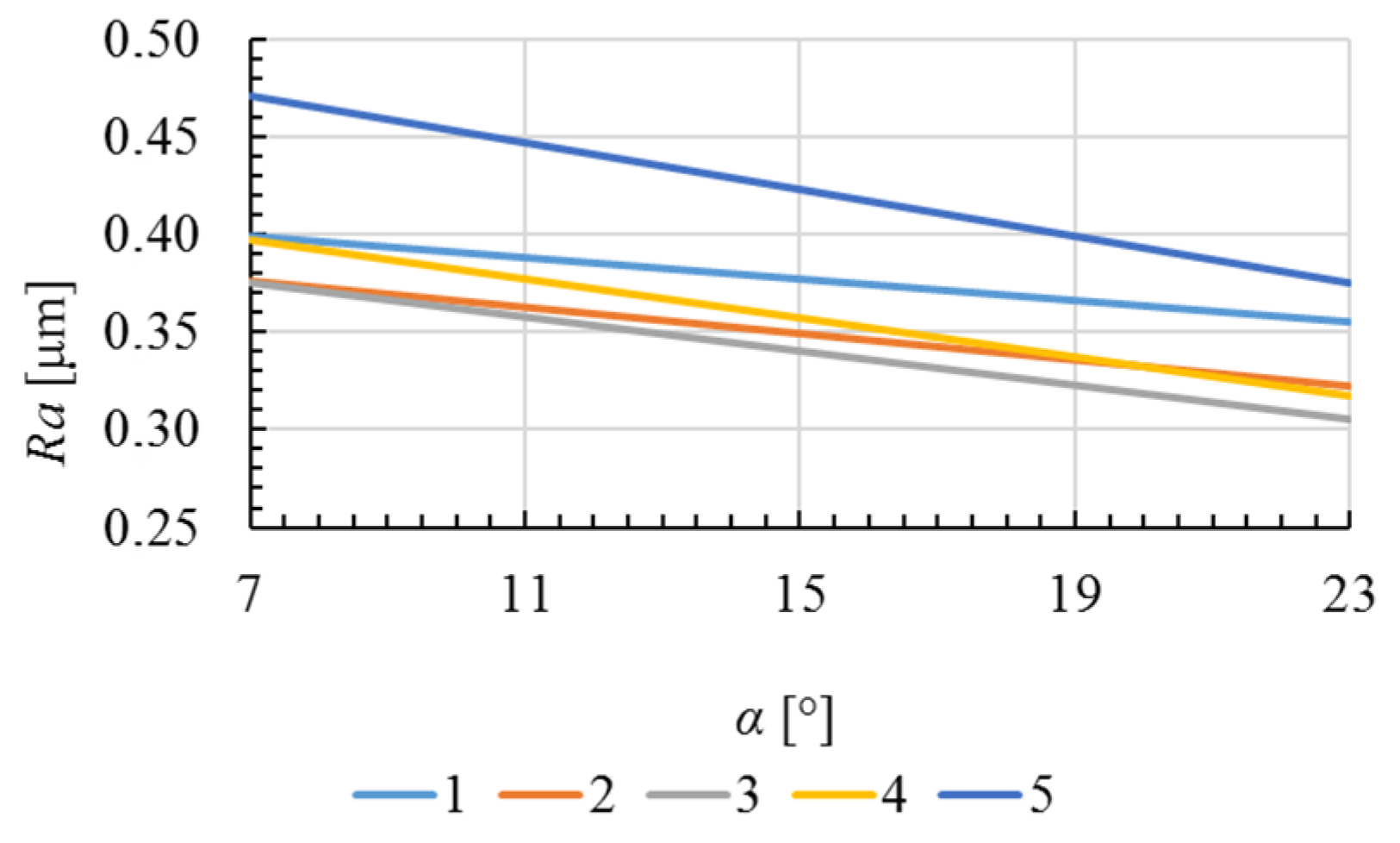

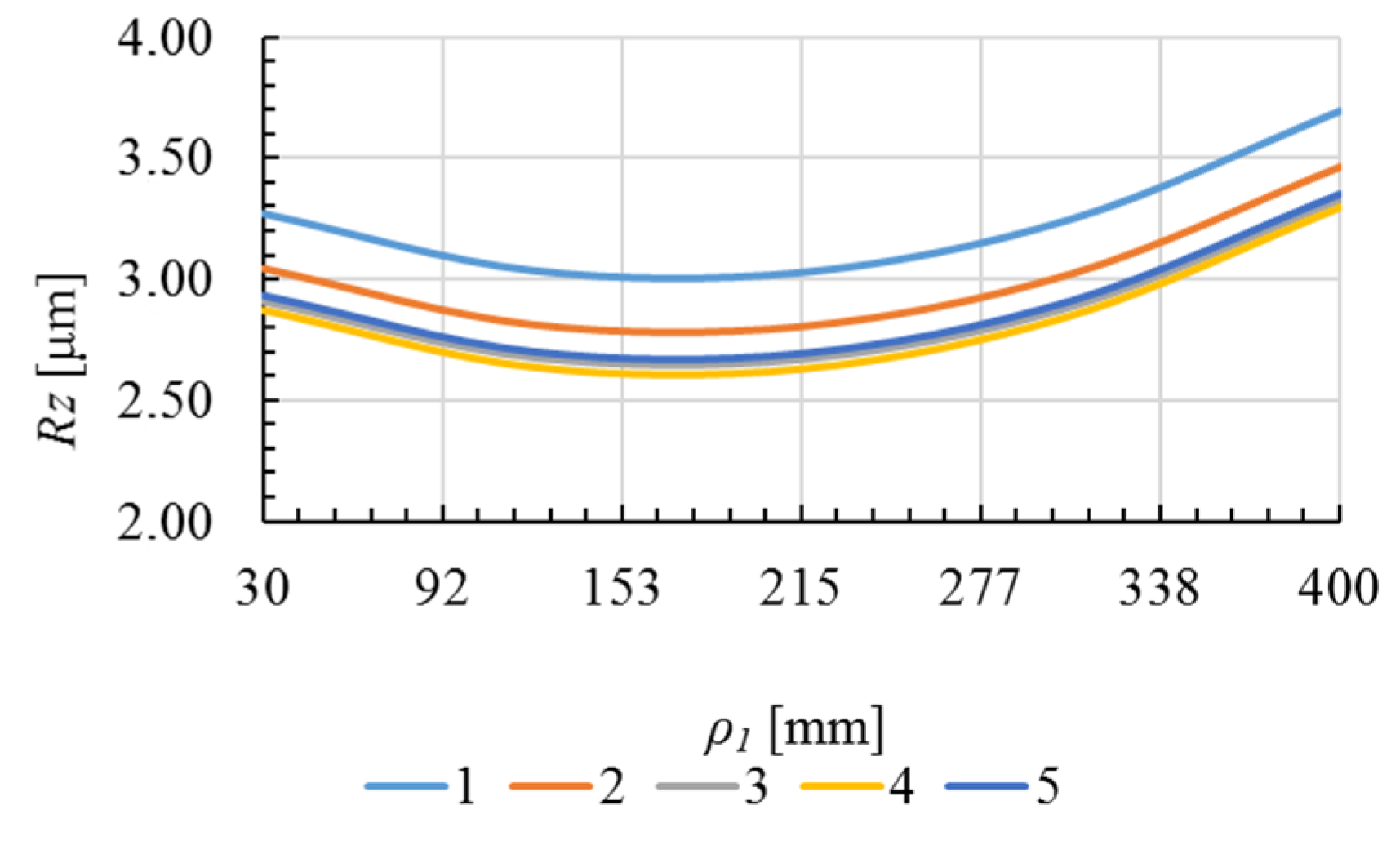
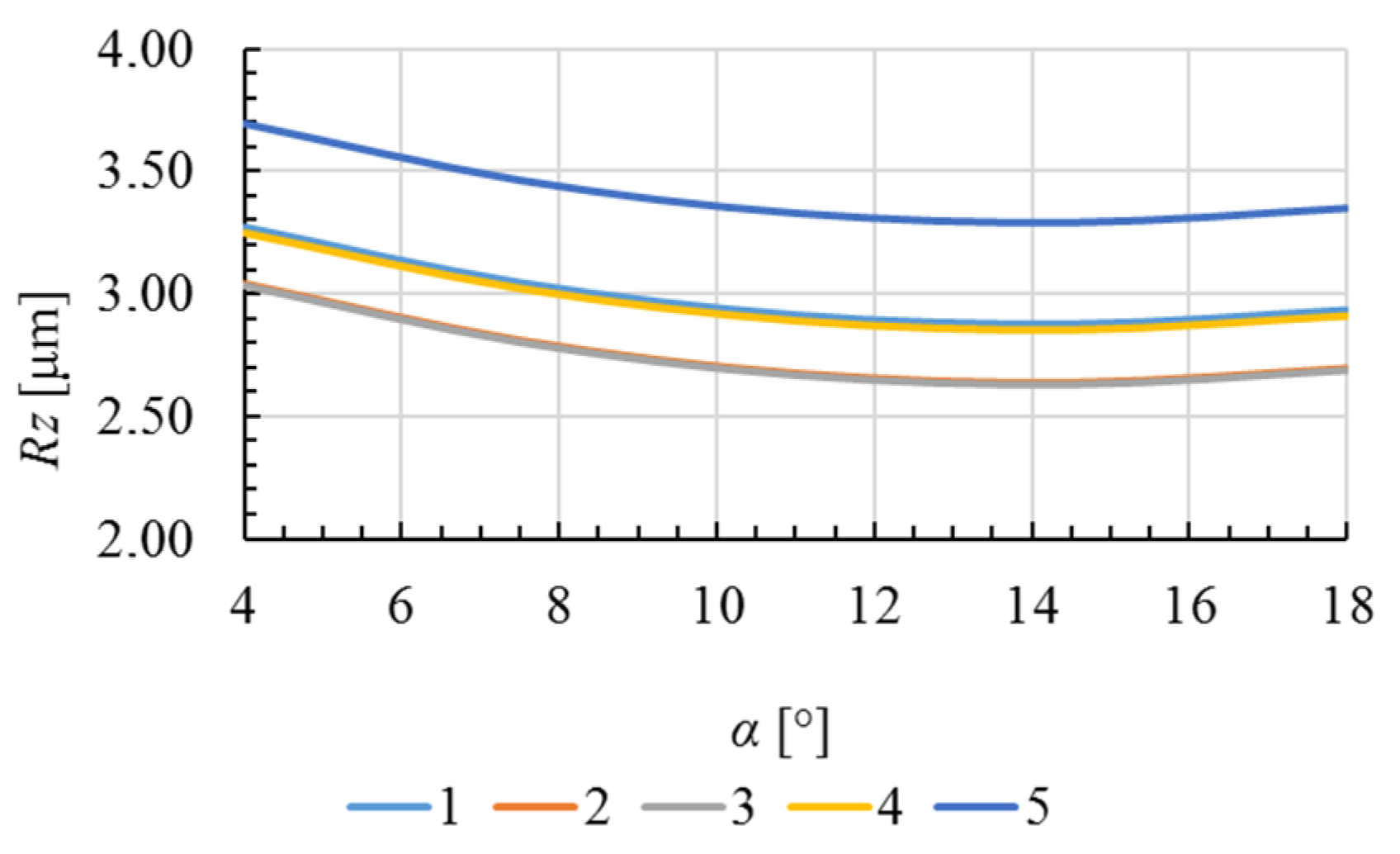
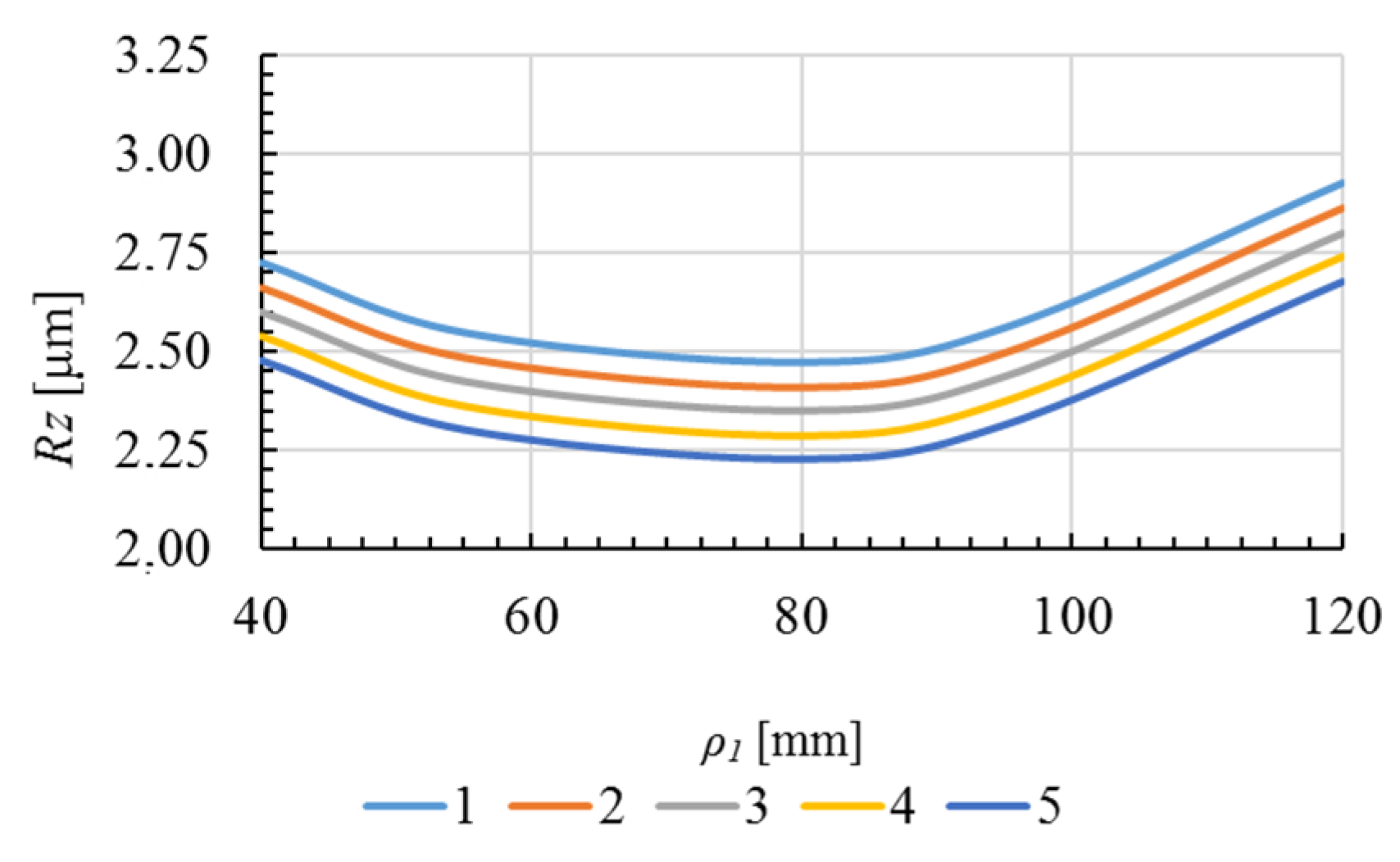
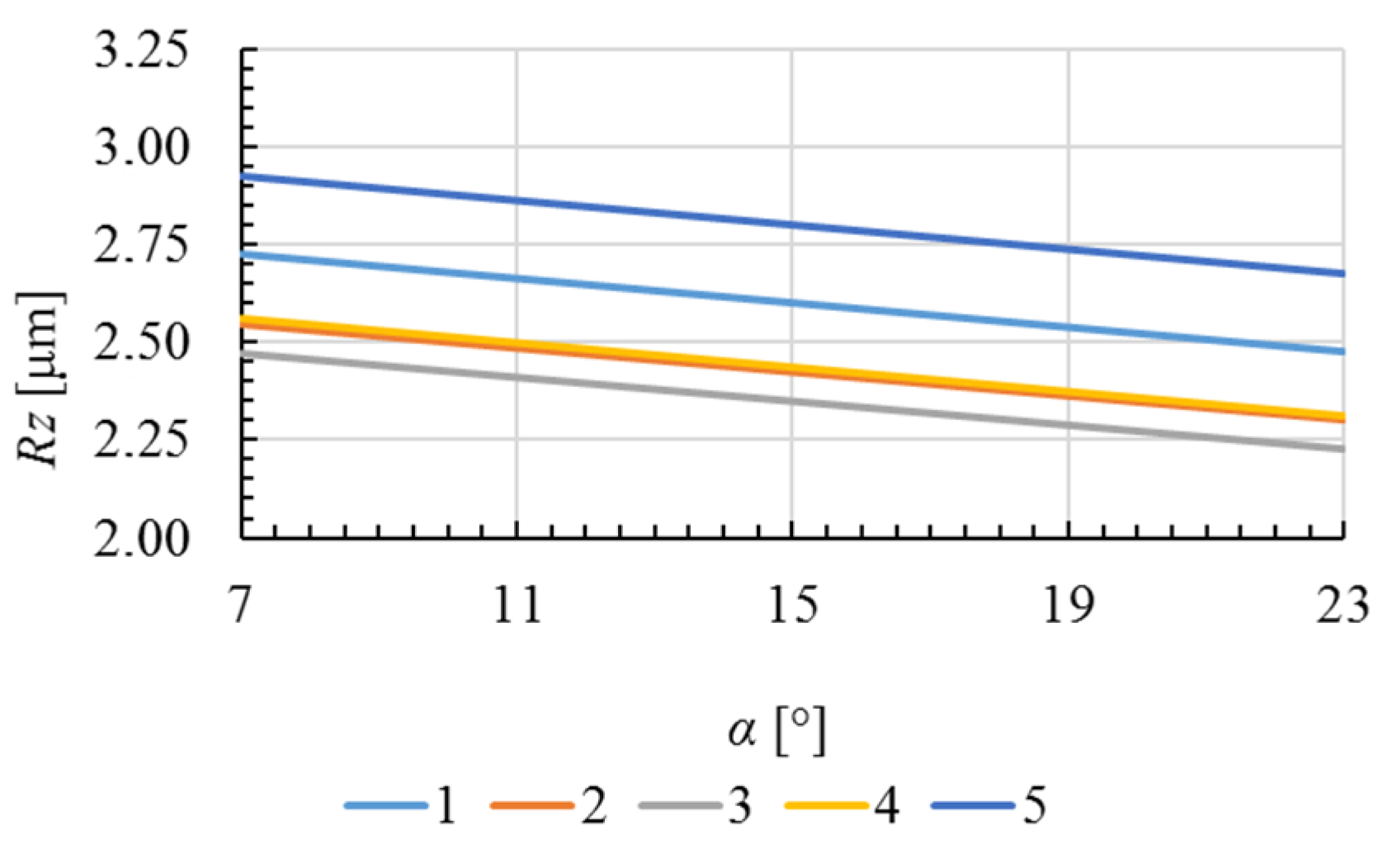
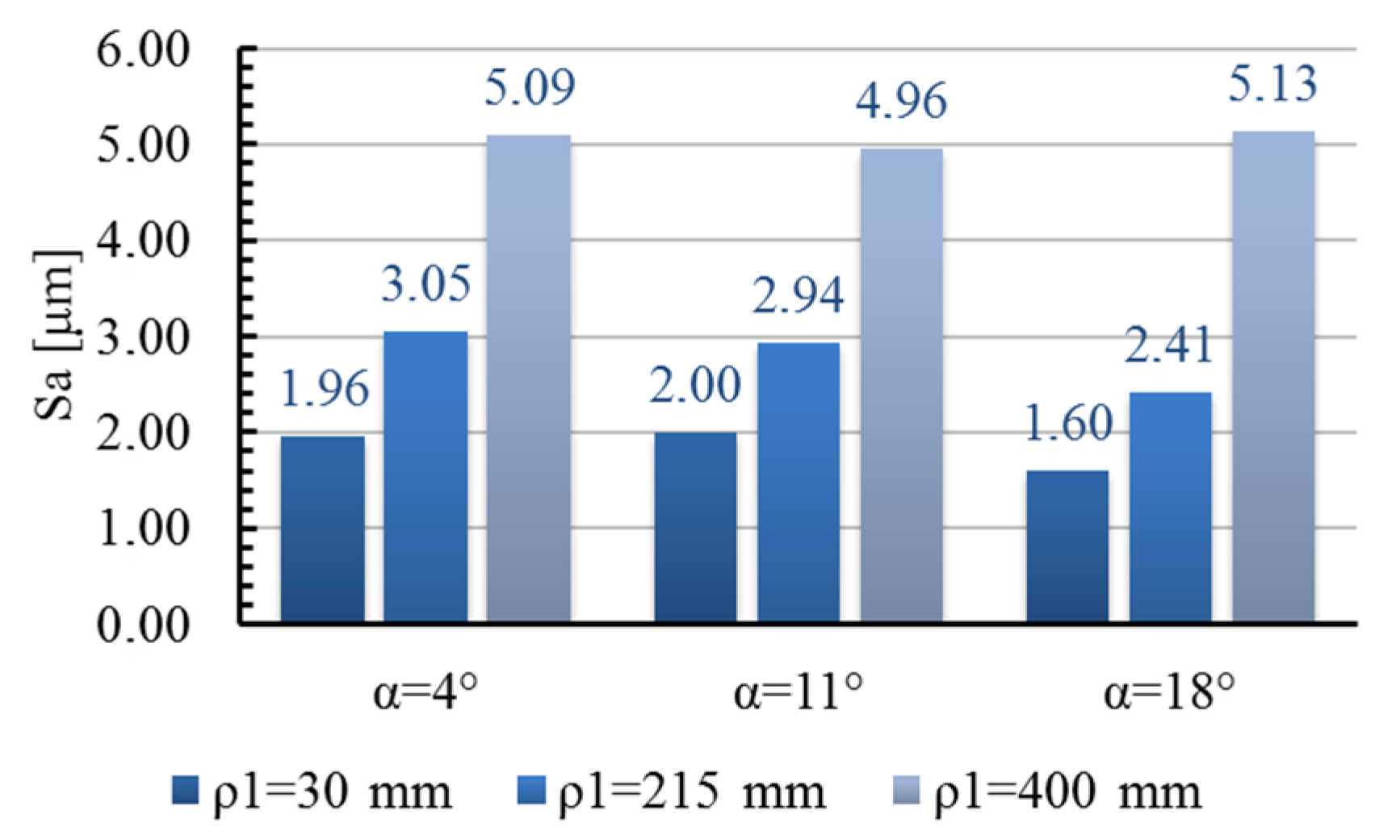
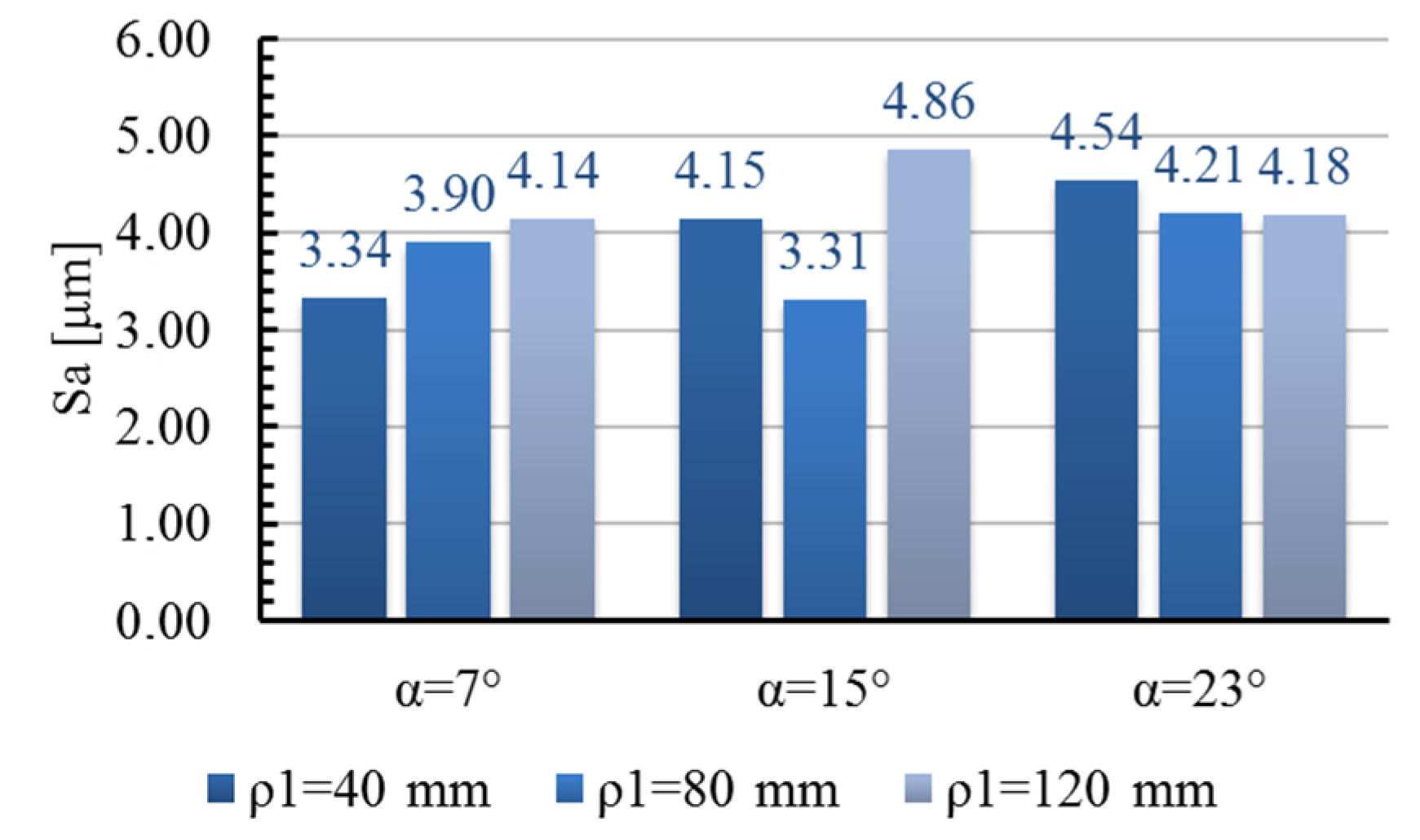

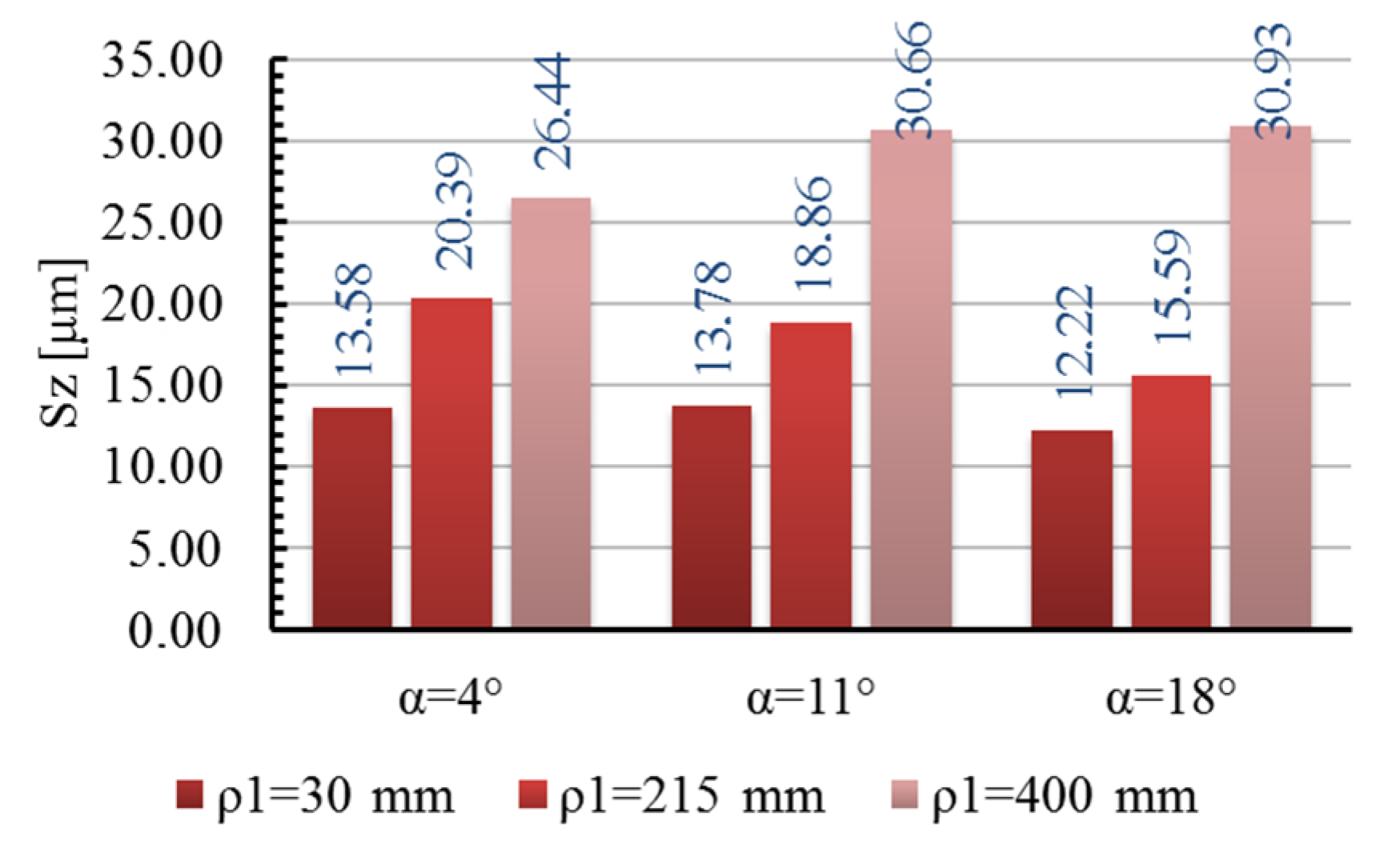
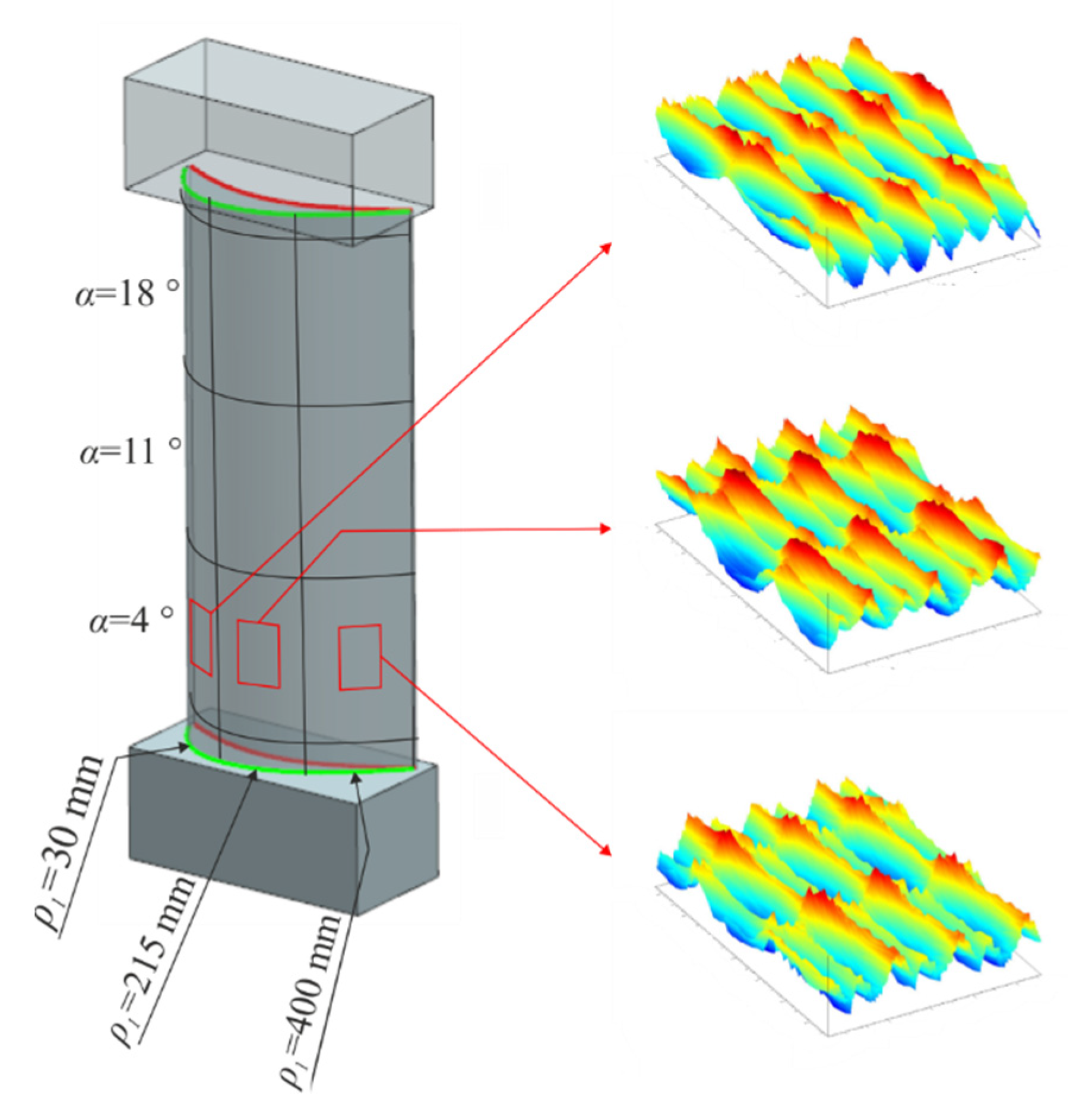
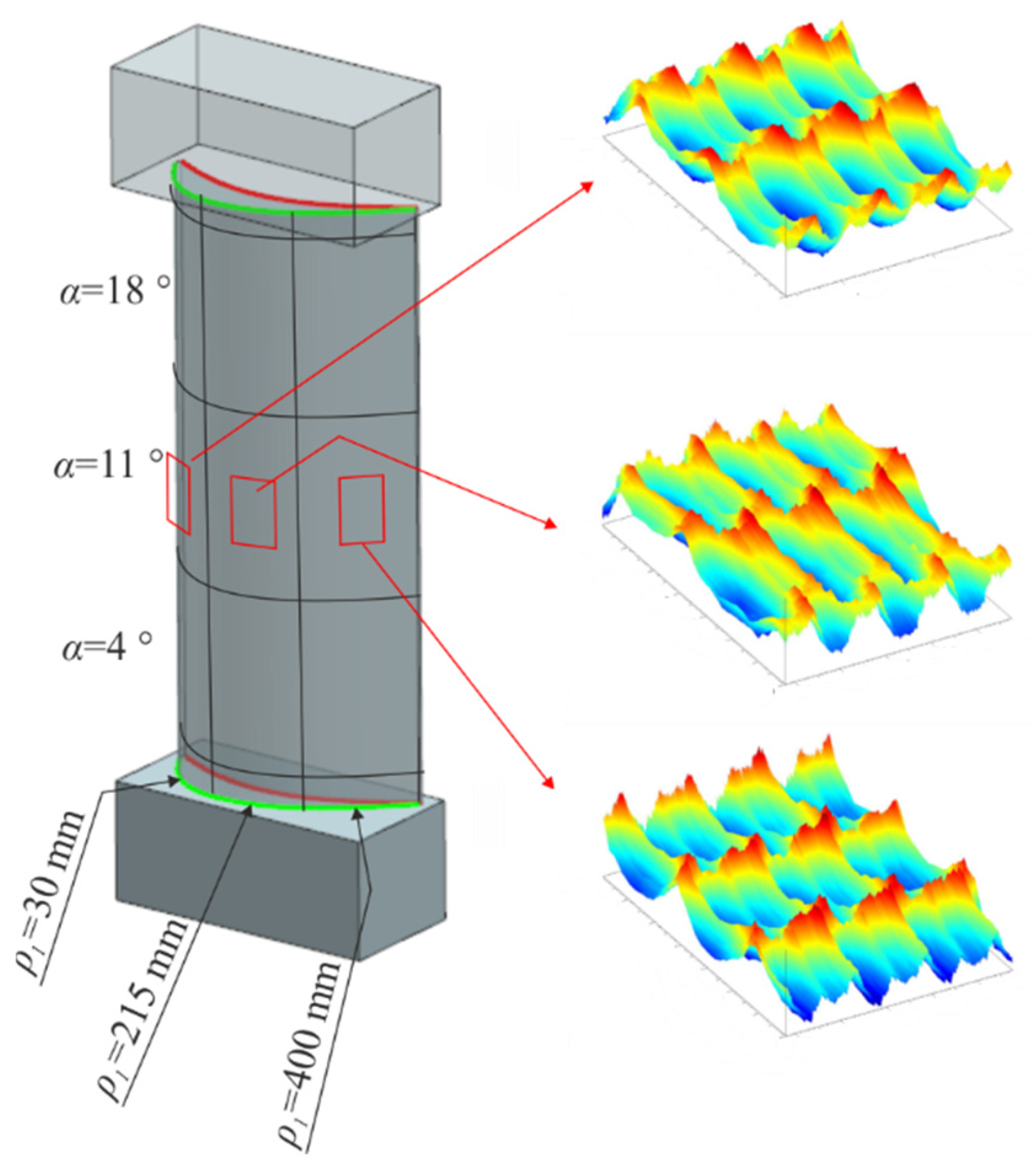

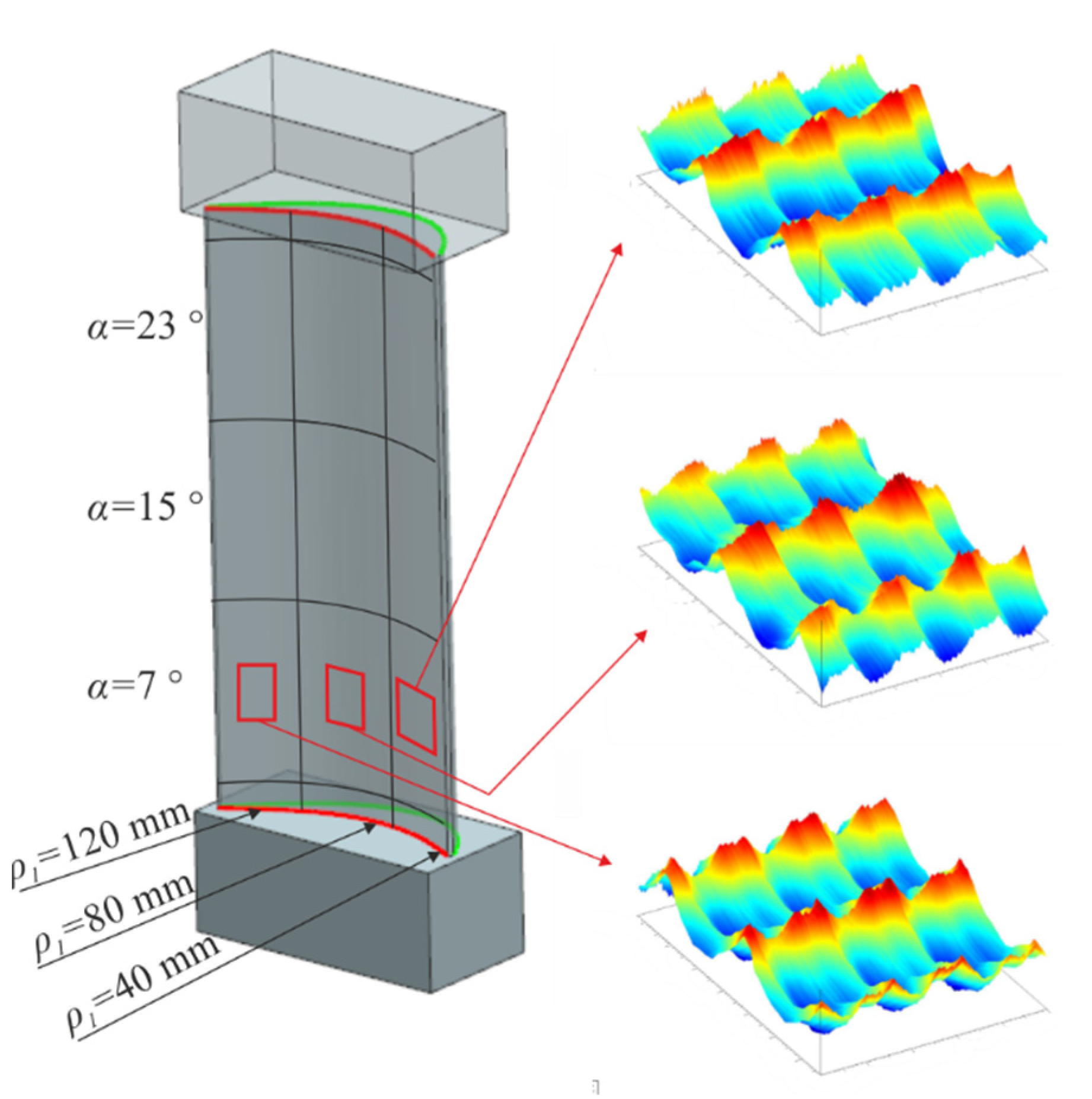

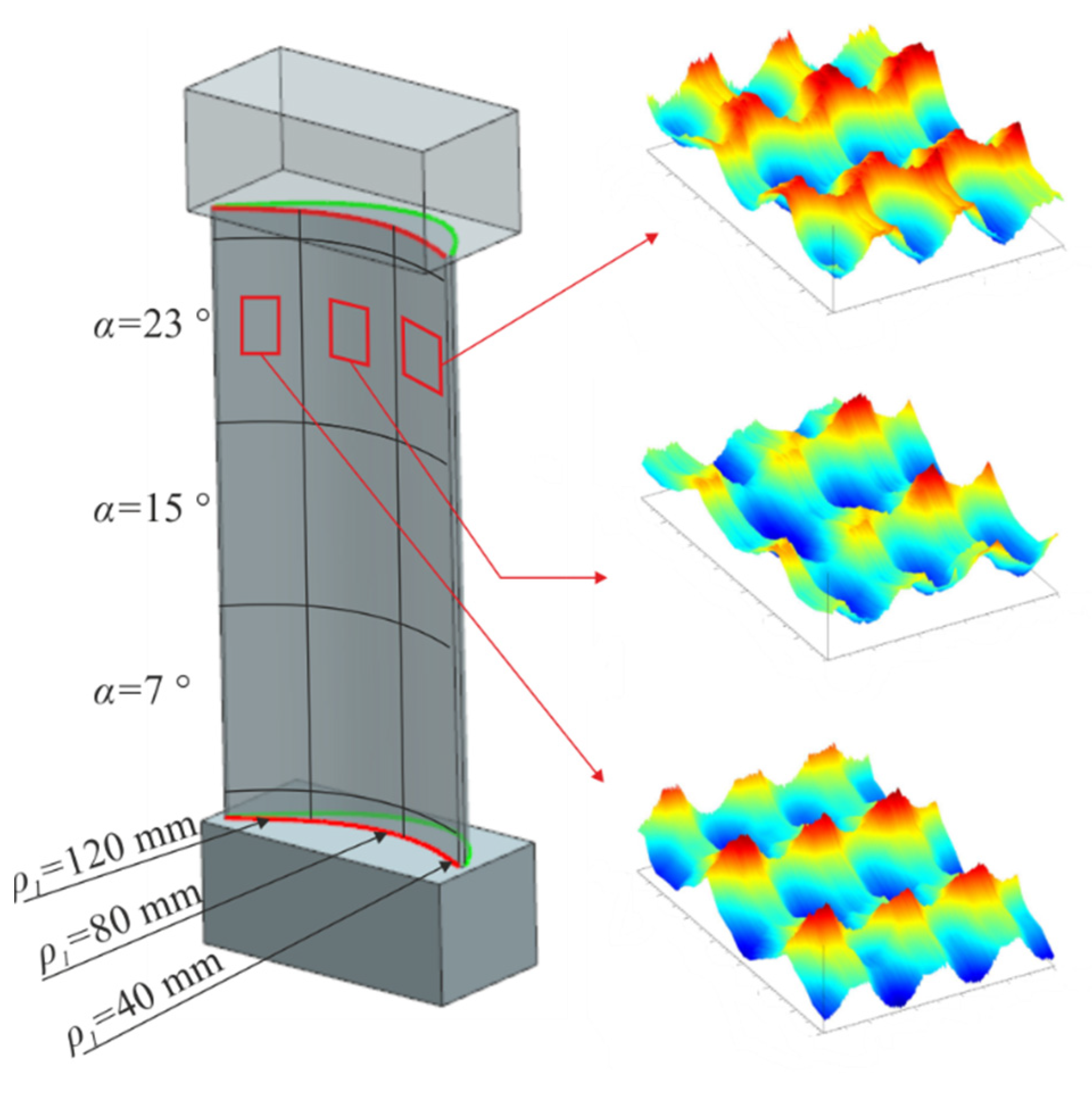
| Fe | Cr | Co | Mo | W | Nb | Al | Ti | C | B | Zr | Ni | |
|---|---|---|---|---|---|---|---|---|---|---|---|---|
| IN718 | 18. | 19 | - | 3 | - | 5.1 | 0.5 | 0.95 | 0.05 | 0.04 | - | 525 |
| Tensile Strength (MPa) | Yield Strength (MPa) | Elastic Modulus (GPa) | Elongation (%) | Density (g/cm3) |
|---|---|---|---|---|
| 1330 | 1120 | 220 | 23% | 8.2 |
| Description | ||
|---|---|---|
| Input variables | X1 | Lead angle α |
| X2 | Curvature radius ρ1 | |
| Output variables | Y1 | 2D and 3D surface roughness parameters |
| Constant factors | C1 | Machine tool |
| C2 | Material | |
| C3 | Toroidal cutter | |
| Limitation | O1 | Minimum lead angle αmin |
| No. | Parameters | Convex Surface Machining | Concave Surface Machining |
|---|---|---|---|
| 1. | ap [mm] | 0.25 | 0.25 |
| 2. | ae [mm] | 1.5 | 1.5 |
| 3. | fz [mm/tooth] | 0.26 | 0.26 |
| 4. | vc [m/min] | 40 | 40 |
| 5. | ρ1 [mm] | ρ1 ∈ <30 ÷ 400> | ρ1 ∈ <40 ÷ 120> |
| 6. | α [°] | α ∈ <4 ÷ 18> | α ∈ <7 ÷ 23> |
| Test Number | Standardized Variables | Squares | Interactions | |||
|---|---|---|---|---|---|---|
| x0 | x1 | x2 | x12 | x22 | x1 × 2 | |
| 1 | + | + | + | + | + | + |
| 2 | + | + | 0 | + | 0 | 0 |
| 3 | + | + | - | + | + | - |
| 4 | + | 0 | + | 0 | + | 0 |
| 5 | + | 0 | 0 | 0 | 0 | 0 |
| 6 | + | 0 | - | 0 | + | 0 |
| 7 | + | - | + | + | + | - |
| 8 | + | - | 0 | + | 0 | 0 |
| 9 | + | - | - | + | + | + |
| Test Number | Convex Surface | Concave Surface | ||
|---|---|---|---|---|
| x1(α) | x2(ρ1) | x1(α) | x2(ρ1) | |
| 1 | 18 | 400 | 23 | 120 |
| 2 | 18 | 215 | 23 | 80 |
| 3 | 18 | 30 | 23 | 40 |
| 4 | 11 | 400 | 15 | 120 |
| 5 | 11 | 215 | 15 | 80 |
| 6 | 11 | 30 | 15 | 40 |
| 7 | 4 | 400 | 7 | 120 |
| 8 | 4 | 215 | 7 | 80 |
| 9 | 4 | 30 | 7 | 40 |
© 2020 by the author. Licensee MDPI, Basel, Switzerland. This article is an open access article distributed under the terms and conditions of the Creative Commons Attribution (CC BY) license (http://creativecommons.org/licenses/by/4.0/).
Share and Cite
Gdula, M. Empirical Models for Surface Roughness and Topography in 5-Axis Milling Based on Analysis of Lead Angle and Curvature Radius of Sculptured Surfaces. Metals 2020, 10, 932. https://doi.org/10.3390/met10070932
Gdula M. Empirical Models for Surface Roughness and Topography in 5-Axis Milling Based on Analysis of Lead Angle and Curvature Radius of Sculptured Surfaces. Metals. 2020; 10(7):932. https://doi.org/10.3390/met10070932
Chicago/Turabian StyleGdula, Michał. 2020. "Empirical Models for Surface Roughness and Topography in 5-Axis Milling Based on Analysis of Lead Angle and Curvature Radius of Sculptured Surfaces" Metals 10, no. 7: 932. https://doi.org/10.3390/met10070932
APA StyleGdula, M. (2020). Empirical Models for Surface Roughness and Topography in 5-Axis Milling Based on Analysis of Lead Angle and Curvature Radius of Sculptured Surfaces. Metals, 10(7), 932. https://doi.org/10.3390/met10070932





